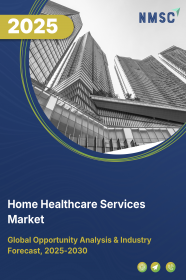
Home Healthcare Services Market by Product Type (Therapeutic Equipment, Monitoring Devices, and Others), by Service Offering Type (Clinical Services, and Personal & Support Services), by Diseases (Cancer, and Others), by Delivery Mode (In-Home Visits, and Others), by Distribution Channels (Direct Provision, Franchise, and Others), by Payment & Contracting (Fee for Service, Insurance, and Others), by End Users (Patients, and Others)– Global Opportunity Analysis and Industry Forecast, 2025–2030
Industry Overview
The global Home Healthcare Services Market size was valued at USD 384.8 billion in 2024 and is predicted to reach USD 418.0 billion by the end of 2025. The industry is predicted to reach USD 641.0 by 2030 with a CAGR of 8.93% from 2025-2030. The market is expanding rapidly, driven by the increasing global aging population, rising healthcare expenditures, and the growing prevalence of chronic diseases.
As more elderly individuals face long-term health conditions, the demand for accessible, at-home care solutions has grown substantially. Increased investment in healthcare systems is improving affordability and encouraging the shift toward personalized, home-based care.
However, limited awareness and trust in home healthcare, especially in developing regions, remain key challenges. Despite this, the market presents significant future opportunities through technological advancements, particularly the integration of AI-powered care robots that enhance patient monitoring, support daily activities, and enable predictive care, offering a promising path for innovation and growth.
The Increase in Aging Population Drives Market Growth
The rise in the elderly population worldwide drives the market as elderly individuals are more prone to chronic cases that increase the need for home care services. In 2024, people aged 65 and older make up 10.3% of the global population, according to United Nations projections.
Between 2024 and 2074, this share is expected to double again, reaching 20.7%. The population aged 80 and above is also growing rapidly and is projected to increase significantly over the same period. This demographic transition is increasing the need for home care, which is important for managing chronic disease and caring for the elderly.
Growing Healthcare Expenditure Fuels the Home Healthcare Services Market Demand
Increasing global healthcare expenditures are significantly enhancing the affordability and accessibility of medical services, thereby accelerating the adoption of home healthcare solutions. For instance, according to a report published by the Centers for Medicare & Medicaid Services (CMS) in December 2024, healthcare spending in the United States rose by 7.5% in 2023, reaching USD 4.9 trillion.
Similarly, provisional estimates from the UK’s Office for National Statistics in 2024 revealed that nominal healthcare spending in the country reached approximately USD 343.11 billion. These substantial investments in healthcare underline a global shift toward more accessible, patient-centered care, reinforcing the expanding role of home healthcare in meeting rising care demands.
Rising Prevalence of Chronic Diseases Fuels Demand for Home-Based Care
The growing prevalence of chronic conditions such as diabetes, heart disease, COPD, arthritis, and cancer is a major factor fueling the demand for home healthcare services globally. These long-term illnesses require continuous monitoring, medication management, and routine care that are increasingly being met through home-based healthcare solutions.
According to the World Health Organization, noncommunicable diseases (NCDs) like heart disease, stroke, cancer, diabetes, and chronic lung conditions now account for 74% of all deaths worldwide, highlighting the urgent need for accessible, long-term care, especially within the home setting.
Limited Awareness Hinders the Home Healthcare Services Market Growth
Limited awareness about the availability, benefits, and scope of home healthcare services remains a key barrier to the growth of the market. In many regions, especially in developing countries, patients and families are either unaware of home-based care options or lack trust in their effectiveness. This lack of knowledge leads to a preference for hospital-based treatment, even when home care could be more convenient, cost-effective, and suitable for managing chronic conditions. As a result, the full potential of the sector remains untapped in several parts of the world.
Integration of AI-Powered Care Robots Presents Future Opportunities in the Market
The market is poised for significant transformation as advancements in technology and AI make care more accessible, personalized, and efficient. In 2025, a British health tech company, “Cera”, exemplifies this shift by developing droid-like robots, powered by its proprietary AI software, to assist elderly and frail individuals in their homes.
These robotic assistants help with daily reminders such as eating, drinking, and medication adherence, while continuously monitoring and collecting health data. This innovation not only enhances patient support but also paves the way for predictive care models, signalling vast future opportunities in AI-driven home healthcare solutions.
Market Segmentation and Scope of the Study
The home healthcare market report is segmented by service offering, disease type, delivery mode, distribution channel, payment model, and end user. Based on service offerings, the market includes clinical services such as skilled nursing, rehabilitative therapy, respiratory and infusion therapy, and hospice and palliative care, as well as personal and support services like home health aides and personal care, medical social work, and case management. By disease type, services cater to patients with cancer, respiratory diseases, movement disorders, diabetes, cardiovascular conditions, pregnancy and maternal care needs, wound care, hearing disorders, and other chronic or acute conditions. Delivery modes include in-home visits, telehealth or virtual-only services, and hybrid models combining both. Distribution channels consist of direct provision, franchise models, online platforms, and retail access. Payment and contracting methods cover fee-for-service, insurance reimbursement, value-based care, and subscription models. End users of home healthcare services include individual patients, family members or caregivers, healthcare agencies and providers, as well as payers and funding organizations.
Geographical Analysis
The North American region dominates the home healthcare services market share, driven by comprehensive government initiatives and a rapidly aging population. Supporting this transformation, the U.S. FDA introduced the Home as a Health Care Hub initiative in 2024, encouraging a paradigm shift where the home is viewed as a vital component of the healthcare system. This initiative promotes the integration of both existing and emerging medical devices within the home setting to support health, enhance wellness, and improve overall quality of life, enabling longer, healthier living for individuals across the region.
In Europe, rising healthcare expenditure is significantly shaping the market landscape. For instance, in 2024, the Netherlands allocated approximately USD 123 billion on healthcare, marking an 8.1% increase from the previous year. Healthcare spending outpaced economic growth, rising from 9.8% to 10.0% of GDP. This growing expenditure trend across Europe is fuelling demand for cost-efficient solutions like home healthcare, which offers quality care while easing pressure on hospital systems.
Asia-Pacific is the fastest-growing region in terms of healthcare demand, driven by a significant demographic shift as population ageing accelerates. According to the World Health Organization (WHO), the proportion of individuals aged 60 and above in the region is expected to rise sharply from 12.2% in 2024 to 22.9% by 2050. Although life expectancy is increasing, many older adults spend these additional years in poor health, requiring long-term care and assistance. This growing need is fuelling the expansion of the industry, which offers a practical solution for delivering continuous, personalized care.
In the Rest of the World (RoW) region, which includes Latin America, the Middle East, and Africa, the market is gradually gaining momentum as healthcare systems evolve. While still in the developing stage, increasing investments in healthcare infrastructure and growing awareness of the benefits of in-home care are driving industry expansion.
Countries such as Brazil, the UAE, and South Africa are witnessing rising demand for cost-effective and accessible home-based care solutions, as they seek to improve care delivery and reduce the burden on traditional healthcare facilities.
Competitive Landscape
Various market players operating in the home healthcare services industry are CVS Health, Amedisys, Gentiva, Baxter Health, Air Liquide Health Care, and others. These companies are adopting various strategies to maintain their dominance in the industry.
-
CVS Health launched its mobile app in 2025, featuring AI-powered search, personalized health to-do lists, conversational chat, and integrations with Aetna and Caremark.
-
In collaboration with CMS, Amedisys launched the Contessa model for dementia care in 2024.
-
Gentiva introduced advanced comfort care programs to enhance quality of life for patients with end-stage cancer, heart disease, and dementia.
-
Baxter Health launched Baxter Health Imaging at Harrison in 2025, bringing state-of-the-art diagnostic imaging services to the local community.
-
In 2025, Air Liquide planned to continue its development in Germany with the acquisition of two outpatient intensive care companies, intensivLeben GmbH and AP-Sachsen GmbH.
Key Benefits
-
The report provides quantitative analysis and estimations of the industry from 2025 to 2035 and assists in identifying the prevailing home healthcare services market opportunities.
-
The study comprises a deep-dive analysis of the current and future home healthcare services market trends to depict prevalent investment pockets in the sector.
-
Information related to key drivers, restraints, and opportunities and their impact on the market is provided in the report.
-
Competitive analysis of the key players, along with their market share is provided in the report.
-
SWOT analysis and Porter's Five Forces model are elaborated in the study.
-
Value chain analysis in the market study provides a clear picture of the roles of stakeholders.
Home Healthcare Services Market Key Segments
By Product Type
-
Therapeutic Equipment
-
Home respiratory therapy equipment
-
Insulin delivery devices
-
Home IV pumps
-
Others
-
-
Monitoring Devices
-
Diabetic care unit
-
BP monitors
-
Multi para diagnostic monitors
-
Home pregnancy and fertility kits
-
Apnea and sleep monitors
-
Holter monitors
-
Heart rate monitors
-
Others
-
-
Mobility & Assistive Devices
-
Wheel chair
-
Home medical furniture
-
Walking assist devices
-
By Service Offering Type
-
Clinical Services
-
Skilled Nursing
-
Rehabilitative Therapy
-
Respiratory & Infusion Therapy
-
Hospice & Palliative Care
-
-
Personal & Support Services
-
Home Health Aide & Personal Care (ADLs)
-
Medical Social Work & Case Management
-
By Diseases
-
Cancer
-
Respiratory Diseases
-
Movement Disorders
-
Diabetes
-
Cardiovascular Diseases & Hypertension
-
Pregnancy/Maternal Care
-
Wound Care
-
Diabetes
-
Hearing Disorders
-
Other
By Delivery Mode
-
In Home Visits
-
Telehealth / Virtual Only
-
Hybrid (In Home + Virtual)
By Distribution & Channel
-
Direct Provision
-
Franchise
-
Online Platform
-
Retail
By Payment & Contracting
-
Fee for Service
-
Insurance Reimbursed
-
Value Based
-
Subscription
By End User
-
Individual Patients
-
Family/Caregiver
-
Healthcare Agencies & Providers
-
Payers & Funds
By Region
-
North America
-
The U.S.
-
Canada
-
Mexico
-
-
Europe
-
The U.K.
-
Germany
-
France
-
Italy
-
Spain
-
Denmark
-
Netherlands
-
Finland
-
Sweden
-
Norway
-
Russia
-
Rest of Europe
-
-
Asia-Pacific
-
China
-
Japan
-
India
-
South Korea
-
Australia
-
Indonesia
-
Singapore
-
Taiwan
-
Thailand
-
Rest of Asia-Pacific
-
-
RoW
-
Latin America
-
Middle East
-
Africa
-
Key Players
-
Care Remedy
-
Sunrise Health Care
-
Cardinal Health
-
Baxter Regional Medical Center
-
Amedisys
-
Interim HealthCare Inc
-
Maxim Healthcare
-
Extendicare
-
CVS Health
-
Apollo Home Care
-
Solaris Healthcare
-
Aveanna Healthcare
-
Bayada Home Health Care
REPORT SCOPE AND SEGMENTATION:
|
Parameters |
Details |
|
Market Size in 2025 |
USD 418.0 Billion |
|
Revenue Forecast in 2030 |
USD 641.0 Billion |
|
Growth Rate |
CAGR of 8.93% from 2025 to 2030 |
|
Analysis Period |
2024–2030 |
|
Base Year Considered |
2024 |
|
Forecast Period |
2025–2030 |
|
Market Size Estimation |
Billion (USD) |
|
Growth Factors |
|
|
Countries Covered |
28 |
|
Companies Profiled |
15 |
|
Market Share |
10 |
|
Customization Scope |
Free customization (equivalent to up to 80 working hours of analysts) after purchase. Addition or alteration to country, regional, and segment scope. |
|
Pricing and Purchase Options |
Avail customized purchase options to meet your exact research needs. |

















 Speak to Our Analyst
Speak to Our Analyst

























